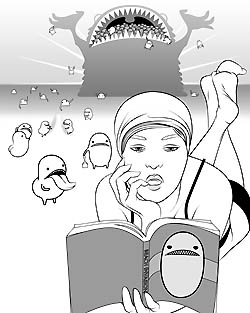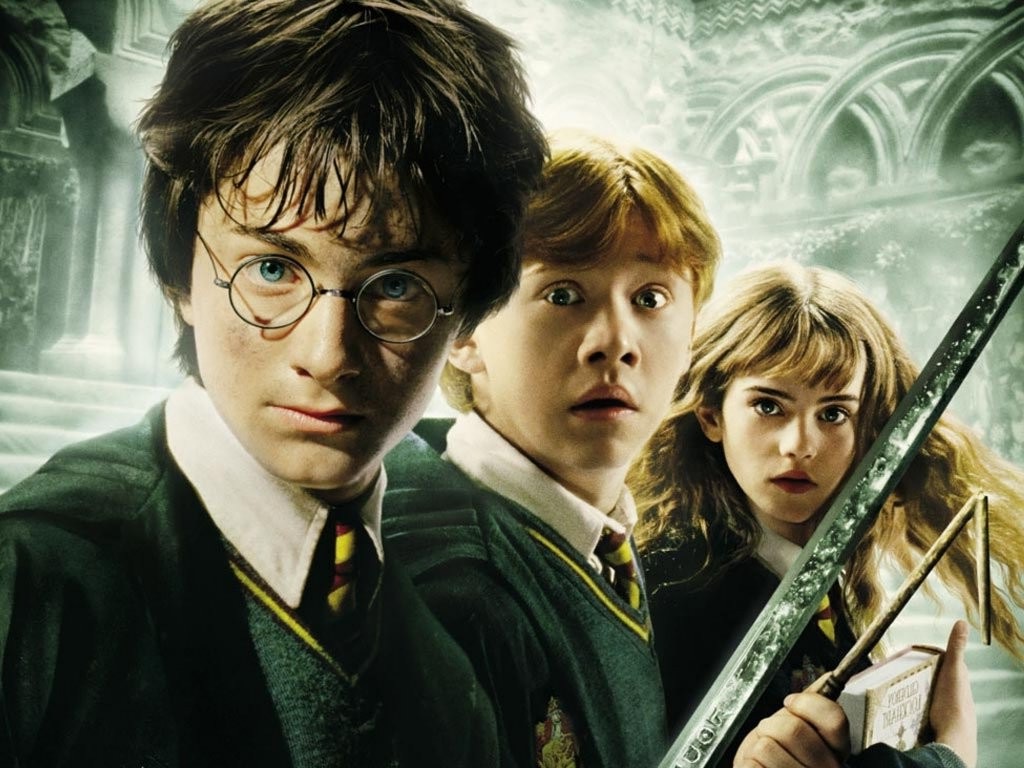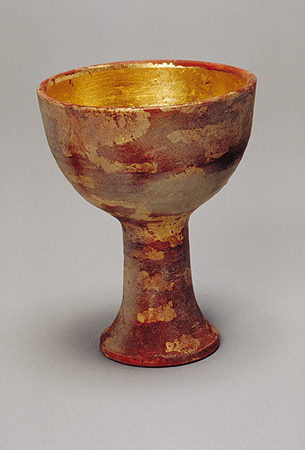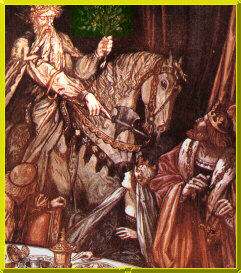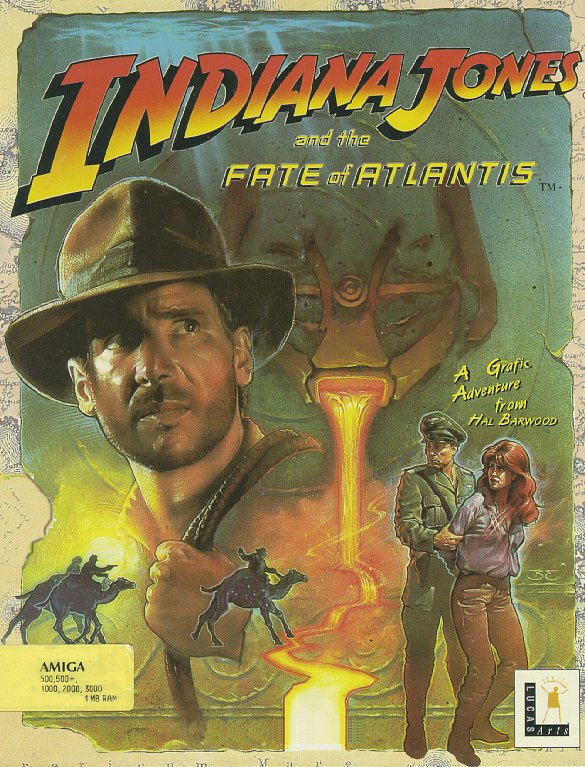|
Irvine Valley College: Online Literature Study of the School of Humanities and Languages Literature 110 - Popular Literature Spring 2013 - Ticket #62740 // Marjorie Coverley Luesebrink, MFA, Instructor
Unit 7c: Fantasy Adventures Harry Potter and the Sorcerer’s Stone, J. K. Rowling
The main components of Fantasy Fiction that arise from Mythological and Folk Referents, then, can be summarized as Stones and Sorcerers, Miraculous Birth, Time Displacement, Creation of Imaginary Worlds, The Quest, and The Conflict Between Good an Evil. As indicated in the notes, many of these elements overlap with the main themes we have considered all along in genre fiction, including "Readable" Characters, Patterned Structure, and Clear Cut Value Systems. However, let us look at some of these stock analytical elements with respect to *Harry Potter* and the series!
Harry and Friends "Readable" Characters One of the most attractive aspects of Rowling's work is the characters she creates! Harry is not only miraculous and likable, he seems to really have just that personality of the very curious, very active, and very "normal" adolescent. [I know that the book even starts out with the fact that the worst thing about the Dursley's is that they consider themselves "normal" - but Harry IS spectacularly normal by most lights.] We dismiss, of course, the Wizardry stuff (which might seem a little strange in a real boy) because this is the point of the novel! Otherwise, Harry has his little rages, his fears, his triumphs, his insecurities, his loyal friendships, his respect for authority and good nature - what is there not to like about him? But I would say that Hermione is even a better match with a kind of stylized reality! I don't go much for the rather glamorous Hermione created by the visual media - she looks way too grown-up for a British boarding school, and way too tricked out (hair, make-up, etc.)
The visual media's Hermione - she looks like she might be enrolled at Corona Del Mar Middle School, but not at Hogwarts! Rather, the Hermione in the book seems to be drawn so closely from the intelligent, enthusiastic, overly helpful, bookworm type. We used to know her so well! She has an affinity with the enthusiasm and community spirit of Dorothy of Oz, the sense of adventure of Nancy Drew, the intelligence of a young Mary Shelley, and so forth. She might have looked more like this:
Other possibilities for Hermione? In any case, she is well-drawn and amazingly lifelike.
Our likable Ron Weasley And Ron. The perfect side-kick and foil - loyal, gullible, and willing to go along with whatever Harry proposes. The "trio" is a very common feature of fantasy fiction - which tends to have a hero or heroine who is then a part of a group of three or five, depending on the action of the story!
Patterned Structure - Reassuring Plot The earliest written story of the Holy Grail dates back to a northern French poet, Chrétien de Troyes, who is credited with starting the whole cycle of Grail Romances beginning in 1188. Chrétien’s Perceval, or the Le Conte du Graal (“The Story of the Grail”), became the prototype for all other legends that followed. In Perceval, a young knight in King Arthur's court, searches out the Grail, which he believes will restore health to the Fisher King, and ultimately to the land and its people. In this story, the Grail is a wide, deep bowl, and not a cup. [I would say, here, that, given the cultures that engendered the grail stories, the grail was probably envisioned by medieval tale-tellers somewhat in the fashion of a wine-drinking bowl. Many of these have been found in ancient grave sites from Celtic cultures.]
One version of *The Holy Grail* description of the Grail from Wikipedia: According to Christian mythology, the Holy Grail was the dish, plate, or cup used by Jesus at the Last Supper, said to possess miraculous powers. The connection of Joseph of Arimathea with the Grail legend dates from Robert de Boron's Joseph d'Arimathie (late 12th century) in which Joseph receives the Grail from an apparition of Jesus and sends it with his followers to Great Britain; building upon this theme, later writers recounted how Joseph used the Grail to catch Christ's blood while interring him and that in Britain he founded a line of guardians to keep it safe. The quest for the Holy Grail makes up an important segment of the Arthurian cycle, appearing first in works by Chrétien de Troyes.[1] The legend may combine Christian lore with a Celtic myth of a cauldron endowed with special powers. The Harry Potter tales have both Quest and a Hero Return plot patterns. In most of the books, both of these structures are worked through the entire novel. The Quest, of course, is the search for something of value that the hero sallies out to find, retrieves after some difficulty, and brings back to a designated spot. *Indiana Jones* movies are notable for the prominence of a quest for some object. But one of the best-known quest stories is *Sir Gawain and the Green Knight* - here is a summary of that important medieval tale.
The Green Knight comes to Dinner! The "hero cycle" as usually defined by Joseph Campbell, allows for a wider range of action - and so encompasses all the rest of the plot action in the Potter books. In the "Hero-Return" Genre, the hero leaves home, meets helpers and opponents, goes through trials, and returns home having gained some form of wealth. In Potter's case, the "return with wealth" might just be coming home from a successful year at school (but he usually adds another notch on his Wizard belt, as well!).
*Indiana Jones and the Fate of Atlantis* - Note the way the Indiana Jones series incorporates the Frontier Story with the Adventure Story - and a good bit of fantasy thrown in, too. But not a parallel world or time distortion. For my Fable and Folktale class, I have done a lecture that surveys Vladimir Propp's analysis of the hero tale in folklore, Joseph Campbell's theories, and the Green Knight. Please do visit this site and read all about the patterns and plots: One Religion all Religions.
Intimacy of Style and Tone Although the intimacy of tone in Rowling's books might be said to come from the fact that she is writing to young adults or teens - or even children - the age group target is not the whole story. Throughout the book we find an easy tone, a relaxed pace, and a definitely friendly tone that is being established between author and reader. Right at the very beginning, Rowling assumes that "we" are on the inside here. All those normal people who don't believe in magic and sorcery can be dismissed out of hand - we readers are in the group that surely understands the presence of the supernatural in the world. From that platform, she can proceed with full confidence and cheerfulness to assume that we are on Harry's side no matter what. Be alert, as you read, for the virtual taps on the elbow, winks of an eye, and occasional shrugs (when those dense people won't see). Bring them to our discussion list - and we can examine how this intimacy of style and tone affects our understanding of the story! Happy Reading!
All along in the Potter stories, we are invited to become a part of the Threesome!
Fantasy: Harry Potter and the Sorcerer's Stone: be sure to see J.K. Rowling's Official Website. A favorite among fantasy fiction readers for years has been The Lord of the Rings - and the entire series by J.R.R. Tolkien. (Note, here, the similarity of naming of "JRR" and "JK" - just another of Rowling's "slant reverences"!) C.S. Lewis blends fantasy and his own brand of Spiritual Humanism - many people are familiar with his Narnia series which has created a whole classic strain in fantasy literature. I do realize that there are many other sub-genres in fantasy fiction - and I will leave it to the students who have particular expertise in this area to help me fill it in! To see the amount of overlap in our "categories", we can take a good look at the 100 best Fantasy Fiction Books published by Fantasy 100: <http://fantasy100.sffjazz.com/>. On this list you will find not only Tolkien and Lewis, but others that we have in different categories such as Stephen King, Anne Rice (Interview with a Vampire), Bram Stoker (Dracula) [all in our Horror category], and Ursula K. LeGuin and Ray Bradbury (who we will find in our Science Fiction Category but also write Fantasy Fistion. There are some amazin authors here! Take a good look for your Research Paper!
Marjorie Coverley Luesebrink: write to me with questions!
Marjorie Coverley Luesebrink, MFA, your Instructor, is a Professor of English in the School of Humanities and Languages, Irvine Valley College, Irvine, California. See Online writing at Home Page. |
| MENUBAR: About Your Class // Class Syllabus // Lecture Notes // Reading List // Recommended Reading // Assignments // Grading Policies // Contact Your Instructor // Announcements // Discussion |
